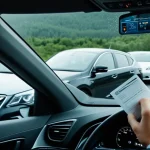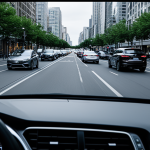Essential Strategies for Confident Parking in Tight UK Spaces
Parking techniques UK require precision and awareness, especially in tight space parking common in urban areas. To park confidently on narrow streets or small garages, start by assessing the space carefully. Use reference points like pavement edges or nearby parked cars to judge distances accurately.
Begin parking by aligning your vehicle in a straight line parallel to the parking spot. Slowly reverse or advance while constantly checking mirrors and blind spots. Use gentle steering inputs to avoid abrupt movements that could cause misalignment or collision. This step-by-step method improves parking confidence by promoting controlled, precise manoeuvres.
This might interest you : Unlocking Optimal Performance: Your Ultimate Guide to Enhancing Crash Sensor Efficiency for Dependable Airbag Activation
Familiarising yourself with typical UK parking scenarios, such as narrow residential streets or compact spaces, also builds valuable experience. Practice slow, deliberate turns in these environments to enhance spatial awareness. Additionally, maintaining calm and focusing on systematic adjustments helps reduce stress when parking in confined UK spaces.
Together, these parking techniques UK nurture skill and confidence, enabling drivers to tackle challenging urban spots with ease.
In the same genre : Maximizing Backup Sensor Performance for City Driving: Essential Strategies for Smart Drivers
Leveraging Vehicle Assist Technologies for Better Parking
Enhancing precision and confidence with modern aids
Modern vehicle assist UK technologies dramatically improve parking confidence in tight spaces. Key features include parking sensors, parking cameras, and automated parking systems.
Parking sensors alert drivers to obstacles, using audible warnings to prevent collisions. These are invaluable in tight space parking, where object proximity is hard to judge. Meanwhile, parking cameras provide clear visual feedback, especially rear and 360-degree views, helping drivers align their cars precisely.
Automated parking systems take this further by controlling steering during parking maneuvers. Drivers maintain control of acceleration and braking while the system positions the vehicle accurately. This significantly reduces stress in narrow UK streets or small garages.
Most UK new vehicles offer combinations of these technologies. For example, premium models feature advanced sensors and 360 cameras, while mid-range cars typically include rear cameras and basic sensors. Understanding each technology’s benefits enables drivers to select the right tools to improve parking outcomes. Integrating vehicle assist UK features fosters safer, quicker, and more confident parking experiences.
Practical Applications: Using Vehicle Assist Tools Effectively
A step-by-step guide to maximise technology in tight UK spaces
To use assistive parking technology effectively, start by familiarising yourself with your vehicle’s parking sensors. When approaching a tight spot, sensors emit beeps that increase in frequency as you near obstacles, giving you precise distance feedback. Combining sensor alerts with parking cameras allows visual confirmation, crucial for avoiding posts or curbs hidden from mirrors.
For automated parking, engage the system as per your car’s instructions. These systems typically control steering while you manage the accelerator and brake. Maintain focus and readiness to override if needed. This approach promotes parking confidence by reducing the mental load during complex manoeuvres.
Common issues include sensor misreads in heavy rain or dirt. Regular cleaning prevents false alerts and improves reliability. Practising these technologies’ use in typical UK scenarios, like narrow streets or small garages, builds familiarity and skills, enhancing your overall parking technique UK.
Combining technology with basic spatial awareness supports safer and more efficient parking, especially in challenging environments common across UK cities.
Navigating UK-Specific Parking Challenges
Parking in the UK presents unique challenges, often shaped by UK parking regulations and the prevalence of narrow streets and limited residential spaces. Understanding these rules is crucial for confident and lawful parking. For instance, parking on pavement or in restricted zones is generally prohibited, to maintain safety and accessibility.
When tackling narrow street parking, precise control and use of curb alignment become essential. Adapting your parking technique UK to fit these cramped conditions requires awareness of the space your vehicle occupies and how close you can get to other cars without risking damage or obstruction.
Employing visual aids and markers—such as kerb lines, road markings, and known fixed objects nearby—helps drivers position accurately. These references support steady alignment and reduce the need for multiple adjustments, fostering greater parking confidence. Combining knowledge of legal restrictions with careful spatial judgment ensures safer, smarter parking in the often tight and busy UK urban environment.
Comparing Parking Assist Features in Leading UK Vehicles
Parking technology varies widely across the UK automotive market, impacting driver parking confidence in tight spaces. Leading models combine parking sensors, parking cameras, and automated parking differently to enhance practical usability.
Premium cars like Audi, BMW, and Mercedes-Benz typically feature advanced systems including 360-degree parking cameras and multi-sensor arrays. These models offer comprehensive obstacle detection and assisted steering, aiding precise positioning in tight urban spots. For example, Mercedes’ automated parking can manage complex manoeuvres with minimal driver input, boosting safety and ease.
Mid-range vehicles often provide rear parking sensors and basic camera setups. Though less sophisticated, these assistive technologies still significantly reduce mishaps in narrow streets or small garages, key UK parking challenges. Brands like Ford and Volkswagen focus on user-friendly interfaces that integrate sensors and visual aids smoothly.
Entry-level cars may have simpler assistances, but many now include at least rear sensors. This shift reflects growing demand for vehicle assist UK features, fostering wider driver confidence. Comparing models helps buyers select cars best suited for their parking environments and budgets.








